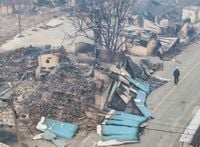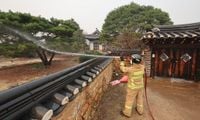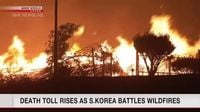South Korea is grappling with devastating wildfires that have claimed at least 24 lives and destroyed over 200 structures across the southern regions of the country. The fires, which began on March 21, 2025, in Sancheong County, have rapidly spread due to strong winds and dry conditions, prompting mass evacuations and significant destruction.
The wildfires have primarily affected North Gyeongsang Province, with cities such as Uiseong, Andong, Cheongsong, Yeongyang, and Yeongdeok suffering extensive damage. The Korea Forest Service reported that more than 43,000 acres have been scorched, and over 27,000 residents have been forced to evacuate their homes.
According to officials, the death toll includes a helicopter pilot who tragically died when his aircraft crashed while battling the blazes. Four firefighters have also lost their lives in the line of duty, highlighting the perilous conditions faced by emergency responders. Reports indicate that many victims were found on roads, suggesting they were caught in the flames while attempting to flee.
In a televised address, South Korea's acting President Han Duck-soo stated, "The wildfires that began last Friday are causing worse damage than many past wildfires. Damages are snowballing, and there are concerns that we’ll have wildfire damages that we’ve never experienced before." He emphasized the need for concentrated efforts to extinguish the fires, which are being fueled by relentless winds.
Firefighting efforts have mobilized nearly 9,000 personnel, including firefighters and military personnel, supported by over 130 helicopters. However, the intense winds have made it challenging to contain the blazes. The government has raised the national wildfire alert to its highest level and designated the affected regions as special disaster zones.
Among the structures lost are historic landmarks, including the Gounsa Buddhist temple, which dates back to the 7th century. The temple suffered severe damage, with nearly half of its 30 buildings destroyed. Two state-designated treasures, a pavilion built in 1668 and another structure from 1904, were also consumed by the flames. Fortunately, monks managed to evacuate a stone Buddha statue, believed to have been created in the 8th century, to safety.
The fires have particularly impacted vulnerable populations, with many elderly individuals among the casualties. Reports indicate that several victims were unable to evacuate quickly enough due to mobility issues. In Yeongdeok, seven people died, with other fatalities reported in Yeongyang, Cheongsong, and Andong. The village head and his wife in Seokbo-myeon, Yeongyang-gun, died while trying to assist residents during the evacuation.
As the situation escalates, criticism has emerged regarding the government's evacuation protocols, particularly for the elderly. Many residents in isolated mountain villages struggled to respond effectively to evacuation orders, raising concerns about the adequacy of communication and preparedness measures. Experts are calling for improved evacuation plans that cater specifically to the needs of elderly and vulnerable populations.
In addition to the human toll, the fires have threatened cultural heritage sites, prompting a desperate race against time to protect these invaluable assets. The UNESCO-listed Hahoe Village and Byeongsan Seowon Confucian Academy were also in danger, with flames approaching perilously close to these historic sites.
As firefighters continue to battle the blazes, weather forecasts predict a small amount of rain—between 5 to 10 millimeters—on Thursday, which authorities hope will aid in extinguishing the fires. However, the lack of significant rainfall has intensified fears about the ongoing crisis.
On the ground, the situation remains critical. Firefighters are working tirelessly to contain the flames, but with strong winds persisting, many are left wondering how much more devastation will occur before the fires are brought under control. The South Korean government has promised to conduct a thorough review of its wildfire response once the crisis is managed, aiming to improve prevention strategies for the future.
In the face of this unprecedented disaster, the resilience of the South Korean people and their emergency services will be tested as they navigate the challenges presented by these wildfires. The ongoing situation serves as a stark reminder of the fragility of life and the importance of preparedness in the face of natural disasters.







